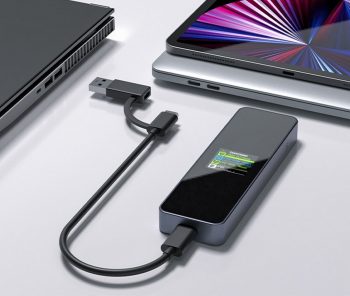
DockCase is the smart SSD enclosure you’ve always wanted
There is a reason why SSDs tend to be more favored over regular HDDs. This is because regular hard drives, both external and internal, rely on a spinning platter. This means that over time, things can wear out and that means that access to your drive will be slower than before, not to mention there’s also a risk of failure which could result in you losing all your data.
SSDs, on the other hand, do not have the same mechanical components so not only do they last longer (they’re not impervious to damage or wear and tear, but generally the issues that would affect a HDD aren’t as applicable to an SSD), but they’re also much faster making it perfect if you want to quickly transfer data between computers.
The cost of SSDs have gone down quite a bit over the years where they are more affordable than they were back in the day, but they still aren’t exactly what you would call cheap, so taking an external SSD out with you can sometimes be an expensive risk, but that’s where Seesaw’s DockCase comes in.
https://www.kickstarter.com/projects/767329947/dockcase-worlds-safest-m2-nvme-smart-ssd-enclosure
The DockCase is basically an enclosure for an M2 NVMe SSD, the same component that you would typically find mounted onto a computer’s motherboard. There are several benefits to using this enclosure, so let’s find out what you can expect.
Sleek and durable design
With the DockCase, Seesaw has designed it to be just slightly bigger than the module itself, meaning that the overall footprint of the enclosure is still pretty small. In fact, it’s small and slim enough that you could easily slip it into your pocket or backpack and it will barely take up any space.
The case itself isn’t just any regular case and it actually comes with a small screen that shows you information related to your SSD which we will get to in a bit. The case is also made using aluminum and tempered glass so it is actually pretty sturdy and has a nice premium feel and finish to it.
If you’d rather not worry about dropping it or scratching the aluminum or the glass, don’t worry because there is also a silicone case that will add an extra layer of protection in case you drop it, so it will protect both the external case and the internal SSD.
Data protection
Sometimes this cannot be helped, but what the DockCase tries to do is minimize the effects in those situations. Seesaw has built-in a feature called Power Loss Protection where the enclosure can actually provide about 10 seconds of writing time after power failure, meaning that not only will this ensure no data loss, but also no damage to your drive.
Built-in screen
This includes the brand of the SSD you’re using, its capacity, the firmware version, the remaining lifespan measured in percentage, and how long it’s been on. It also shows you the power cycles, the number of written or read units, and so on.
With all this information presented to you that you can easily see at a glance, it means you know when your SSD is reaching the point where it might fail, which also means that it might be time to get another one to backup your existing one so that you don’t wake up one day and the drive is no longer working.
Quick and stable transfers
Speed is of course crucial, but can it maintain that speed, that is the question. Some enclosures might boast certain transfer rates but it might fall off after a while, but according to Seesaw’s testing of the DockCase, it is capable of maintaining a steady transfer rate of close to 1000MB/s.
Conclusion
All in all, the DockCase is actually a pretty nifty device if you’re looking for customizability and flexibility in terms of your external storage needs. It also has the added bonus of being able to protect your data to ensure that you don’t suffer from data loss, and features like the built-in screen is actually a pretty cool feature.
If you’re interested, the DockCase is currently on Kickstarter trying to raise funds where an early bird special of $69 will nab you one of the enclosures (SSD not included) once the project is complete, so head on over for more details.